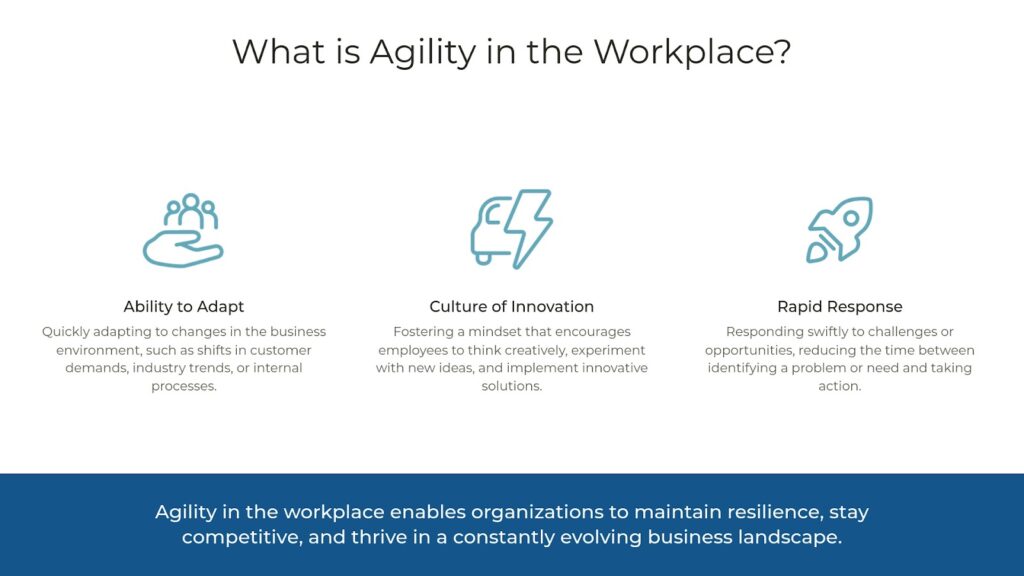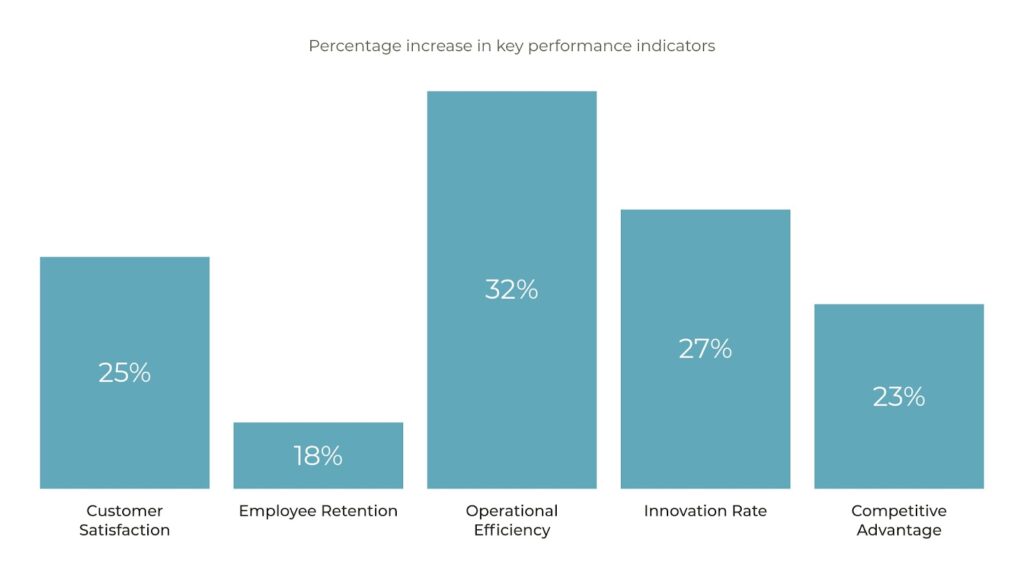The ability to adapt quickly in today’s business has never been more crucial. Businesses are no longer operating within the confines of slow-moving processes or predictable market trends. Instead, they face constant changes in technology, consumer behavior, and economic conditions. As a result, the importance of agility in the workplace has become a critical factor in driving business success. In this article, we will explore how agility skills in the workplace empower organizations to stay ahead of the curve, foster innovation, and maintain competitiveness, while also delving into why agility is important in business.
What is Agility in the Workplace?
Agility in the workplace refers to an organization’s ability to quickly adapt, innovate, and respond to changes in the business environment. It involves more than just the willingness to embrace change; it is about having the skills, processes, and mindset that enable teams to pivot rapidly while maintaining efficiency and productivity. Whether it’s responding to a shift in consumer demand, adapting to new regulations, or implementing cutting-edge technologies, workplace agility ensures that businesses can effectively navigate challenges and seize new opportunities.

Why is Agility Important in Business?
The core reason why agility is important in business is that it allows organizations to maintain resilience in the face of uncertainty. In a highly competitive market, the most agile companies are often the ones that thrive. Here’s why:
- Faster Decision-Making: Agile businesses can make informed decisions quickly, reducing the time between identifying a problem or opportunity and taking action.
- Improved Adaptability: The ability to adapt swiftly to changes in customer needs, industry trends, or internal processes is key to sustaining growth.
- Greater Innovation: Workplace agility fosters a culture of continuous improvement, where employees are encouraged to think creatively and innovate.
- Enhanced Customer Satisfaction: Organizations that are agile can rapidly respond to customer feedback and changing preferences, leading to higher satisfaction rates.
- Better Employee Engagement: Agility skills in the workplace often result in higher employee engagement, as staff feel more empowered to contribute ideas and drive change.
The Role of Agility Skills in the Workplace
Agility skills in the workplace go beyond having flexible strategies; they encompass a range of competencies that individuals and teams possess to respond efficiently to changes. These skills can be grouped into three key areas:
1. Cognitive Agility: Thinking Fast and Flexibly
Cognitive agility involves the mental capacity to think quickly, switch between tasks efficiently, and manage multiple responsibilities. Employees with strong cognitive agility are skilled in problem-solving, decision-making, and critical thinking, which are essential for adapting to new challenges.
- Problem-Solving Skills: Teams that can identify challenges and develop quick solutions help businesses respond effectively to unforeseen circumstances.
- Decision-Making Skills: Fast and informed decision-making is crucial in ensuring that companies can pivot quickly, keeping projects and processes aligned with new objectives.
- Strategic Thinking: Agility in the workplace is fueled by strategic thinking, which allows employees to anticipate changes and plan accordingly.
2. Emotional Agility: Adaptability and Resilience
Emotional agility refers to the ability to manage emotions, handle stress, and maintain focus during periods of change. In a fast-paced work environment, emotional agility ensures that employees can remain calm under pressure and adapt to shifting circumstances without losing productivity.
- Adaptability: An adaptable workforce is prepared for unexpected changes, whether it’s a shift in project scope or a major organizational overhaul.
- Resilience: Agility skills in the workplace also foster resilience, enabling employees to bounce back from setbacks and remain motivated in the face of adversity.
- Collaboration and Communication: Agile teams often excel at collaboration, as clear and effective communication is crucial for driving alignment during change initiatives.
3. Technical Agility: Embracing New Tools and Technologies
Technical agility is about how well employees can adapt to new tools, software, and processes. In today’s digital age, technical agility is a must-have skill in the workplace, as technology plays a central role in driving innovation and operational efficiency.
- Learning Agility: The ability to quickly learn and apply new skills is vital for keeping up with technological advancements.
- Process Agility: Employees who can swiftly adapt to new workflows, software updates, or automation tools contribute to seamless transitions in operations.
- Innovation: Technical agility supports innovation by encouraging employees to explore and implement new technologies that enhance productivity and create value.
How Agility Skills Drive Business Success
Agility skills in the workplace are more than just buzzwords; they are fundamental components of a thriving business. Let’s examine how these skills contribute to business success:

1. Driving Innovation and Competitive Advantage
Innovation is at the heart of workplace agility. Agile organizations encourage employees to think creatively, experiment with new ideas, and quickly implement solutions. This fosters a culture of innovation, where teams are not afraid to try new approaches, fail fast, and learn from mistakes. This culture of continuous improvement can give businesses a significant competitive advantage, as they are always one step ahead of slower-moving competitors.
2. Fostering Adaptability and Rapid Response to Change
Agility skills in the workplace enable businesses to respond rapidly to changes in market conditions, regulatory requirements, or customer preferences. This adaptability reduces downtime, minimizes disruptions, and ensures that the organization remains aligned with its goals. For recruitment agencies, which often face sudden changes in hiring trends or client demands, being able to pivot quickly is essential to maintain client satisfaction and success.
3. Enhancing Employee Engagement and Retention
Workplace agility isn’t just beneficial for business outcomes—it also positively impacts employee engagement and retention. When employees feel empowered to contribute ideas, adapt quickly to changes, and take ownership of their work, they are more likely to be satisfied with their roles. This engagement leads to lower turnover rates, as employees feel valued and invested in the company’s success.
4. Improving Customer Satisfaction and Loyalty
Agile businesses are customer-centric. They can quickly adapt their products, services, or approaches based on real-time feedback from customers. This customer-centric approach drives satisfaction, as clients feel heard and valued. In the context of recruitment agencies, agility skills in the workplace can enhance client relationships by delivering customized solutions faster and more efficiently.
5. Reducing Operational Costs and Increasing Efficiency
One of the practical benefits of agility in the workplace is cost reduction. Agile businesses can quickly identify inefficiencies, eliminate waste, and optimize processes. This streamlined approach not only cuts costs but also increases overall efficiency. By maintaining lean operations, companies can reallocate resources toward growth initiatives, research and development, or employee training.
How to Implement Agility Skills in the Workplace?

To harness the benefits of agility in the workplace, businesses need to actively cultivate these skills across their teams. Here’s how organizations can develop agility skills in the workplace:
- Promote a Culture of Learning
Encouraging a culture of continuous learning is a foundational step in building workplace agility. Providing access to training programs, workshops, and skill-building sessions enables employees to keep up with the latest industry trends, technologies, and practices.
- Encourage Open Communication and Collaboration
Fostering open lines of communication is crucial for agility. Employees need to feel comfortable sharing ideas, providing feedback, and collaborating with colleagues across departments. Creating cross-functional teams and encouraging transparent communication channels can boost agility.
- Invest in Technology and Tools
Equipping teams with the right tools and technology is essential for driving workplace agility. Investing in collaboration software, project management tools, and data analytics platforms can enhance employees’ ability to work efficiently and adapt to new demands.
- Empower Decision-Making at All Levels
Agile organizations delegate decision-making authority to lower levels, allowing employees to make faster and more informed decisions. This empowerment not only improves agility but also increases accountability and job satisfaction.
- Lead by Example
Leadership plays a pivotal role in promoting workplace agility. Leaders who demonstrate agile behaviors, such as quick decision-making, adaptability, and a willingness to embrace change, set the tone for the entire organization.
Conclusion
Agility in the workplace is not just a nice-to-have; it is a critical driver of business success. The ability to adapt quickly, innovate continuously, and respond to changes effectively is what sets successful businesses apart from their competitors. Agility skills in the workplace help organizations foster innovation, improve customer satisfaction, enhance employee engagement, and increase operational efficiency. For recruitment agencies, in particular, agility ensures that they can meet the changing needs of clients and candidates in a highly dynamic industry.
Investing in agility skills is about thriving in a complex, fast-moving business world. To ensure your organization stays ahead, Sign up on JobsPikr for real-time labor market insights, helping you build an agile, data-driven approach to workforce planning and recruitment.



